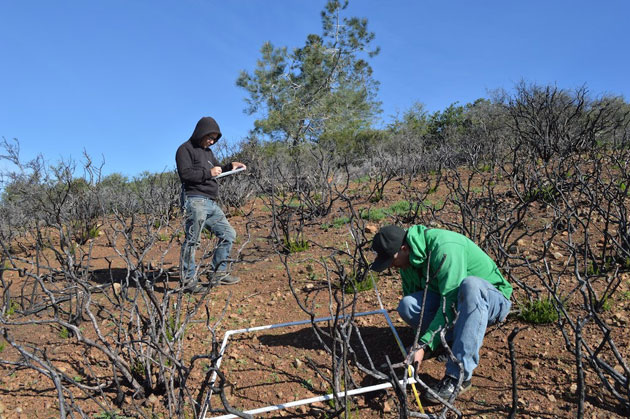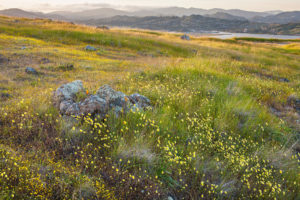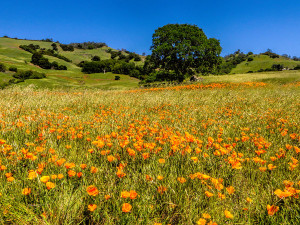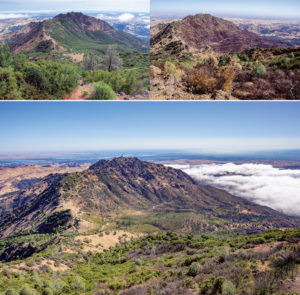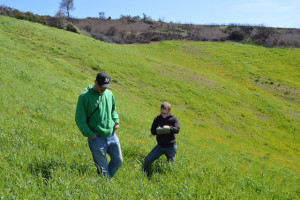This article is part of a monthly series of photos and articles on the transformation of Mount Diablo following the 2013 Morgan Fire, funded by special donations from Bay Nature readers. You can find our stories, as well as event listings, iNaturalist sightings, and magazine features, at baynature.org/diablo.
t 8 a.m. on a Sunday morning in April, Heath Bartosh and Brian Peterson pile into a truck headed for the summit of Mount Diablo. Armed with some rope, a plant press, and a one-meter square made of PVC pipe, they’re off to measure the mountain’s recovery from last September’s big fire.
Bartosh is the senior botanist at Nomad Ecology, a Martinez-based ecological consulting firm. Peterson is a graduate student in ecology at San Francisco State. They have a small grant from State Parks, but they’re donating oodles of time too. This is the biggest fire to hit the mountain in almost 40 years, and they’re determined to learn as much as they can. “Science isn’t a job, it’s a lifestyle,” Bartosh laughs.
An expert in rare plants, Bartosh is especially interested in “fire followers,” plants whose seeds stay buried in the ground until heat or smoke stimulates germination. These annuals flourish in what were once woody plant communities for one to three years. And then they’re gone—until the next fire.
Bartosh calls this phenomenon “fleeting abundance.” He studied it after the Basin Complex Fire at Big Sur a few years ago. He plans an even more comprehensive look at Mount Diablo. For the next three years, Bartosh, Peterson, and two other team members will note which fire followers appear, what habitats they prefer, how much ground they cover, how long they stay, and what species eventually push them out. They’ll look at other plant species, too, in an effort to deepen understanding of how Mount Diablo plants respond to fire.
Today we’re on a test run to refine the study’s methods. We arrive at a steep slope. Once a graveyard of black soil and vertical sticks, now it’s showing signs of life. Mount Diablo’s dominant chaparral plant, chamise, is sprouting at the sticks’ bases. Other greenery is popping up on the soil in between.
Some of these plants show little more than a leaf or two, but Bartosh still knows their names. At 25 points along a 50-meter line, Bartosh plops down a one-meter square, and rattles them off:
“1% chamise stump sprouts
0.25% chamise from seeds
0.25% Phacelia sp.
1% asteracious weed
0.1% Baccharis sp.
1% Emmenanthe
rabbit turds.”
That last item draws a chuckle from Peterson, but the second-to-last item, Emmenanthe penduliflora, or “whispering bells,” is reason for celebration. Its star-shaped sprouts and pale yellow flowers have been largely absent from the mountain since the late 1970s. Now, it’s common in burned chaparral. In fact, it’s everywhere. Other fire flowers, including golden eardrops (Ehrendorferia chrysantha, aka earlier as Dicentra chrysantha) and fire poppies (Papaver californicum), may show up in large numbers later, later in May or in June. At least they did after Mount Diablo’s other big fires in 1931 and 1977.
Bartosh and Peterson have invested 80 hours in their survey so far. Their team will begin actual data collection later, when more of the plants are in flower. For three springs in a row, they’ll sample 55 plots in various types of burned habitat. It’s a ton of work, full of drama.
“Nature is pulling back the curtain,” Bartosh says. “Let the play begin. We’ll see who shows up and gives the best performance.”

The 3,100-acre Morgan Fire on Mount Diablo has sparked a broad range of ambitious scientific studies. In addition to Bartosh’s work on fleeting abundance, Mount Diablo State Park has issued permits for studies on insects and spiders (Kipling Will, UC Berkeley), how a combination of drought and fire affects chaparral ecosystems (Paul Fine, UC Berkeley), how fire intensity affects germination of chaparral (Lindsey Hendricks, UC Berkeley), what plants and animals are using burned areas in the first nine months after the fire (Anna Larsen, URS, and Nerds for Nature), what the mountain’s vegetation looked like before the fire (Susan Bainbridge, Jepson Herbarium).

